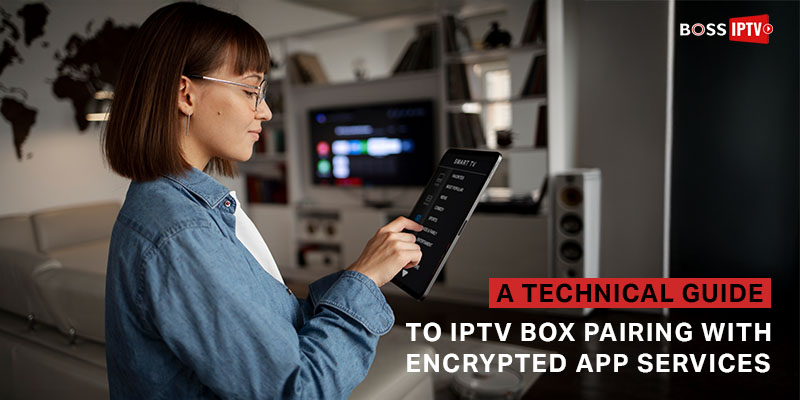
In this digital era IPTV continues to transform home entertainment, several users across the world are switching to IPTV from traditional cable TV to more flexible streaming solutions. But while convenience and content variety are at the forefront, ensuring secure streaming via encrypted app services is now a top priority for both providers and subscribers.
In this guide, we’ll explore the technical process behind IPTV box pairing, encryption, and what makes this combination a game-changer for IPTV in the USA.
Before diving into the pairing process, it’s important to understand what makes IPTV different from traditional broadcasting methods.
IPTV provides TV programs through internet contentions instead of traditional cable. This technology enhance the viewing experience by providing:
Several consumers exploring IPTV reviews find that these services grant access to thousands of channels worldwide which makes them attractive for international programs.
When you are searching for IPTV service providers, you will come across several service categories:
The IPTV market in the USA is still growing, with many providers offering tailored packages aimed at diverse audience segments.
The pairing between an IPTV box and an encrypted app serves multiple purposes:
If you’re browsing IPTV reviews and see terms like “secure pairing” or “anti-piracy support,” these usually refer to encryption protocols used during box-to-app pairing.
A common question among potential subscribers is “IPTV is it legal?” The answer depends entirely on the service provider and content licensing.
Legitimate IPTV providers secure proper licensing agreements for the content they distribute. These services operate within copyright laws and represent the best IP TV service options for consumers concerned about legality.
However, some unofficial providers may distribute copyrighted content without proper authorization. When choosing an IPTV subscription, verifying the legitimacy of your provider helps ensure you’re operating within legal boundaries.
To access IPTV stream services, you’ll need appropriate hardware. Options include:
When selecting hardware, consider factors like processing power, memory, and video output capabilities. These specifications directly impact your streaming quality and overall experience.
For optimal IPTV stream app performance, your network infrastructure should meet these minimum requirements:
Inadequate networking infrastructure frequently causes buffering issues and quality degradation, regardless of your IPTV subscription quality.
Understanding Encryption in IPTV
Encryption plays a crucial role in protecting content and ensuring that only authorized subscribers can access specific channels or features. Most reputable IPTV providers implement some form of encryption to:
These security measures require proper device pairing to function correctly.
The following process applies to most common IPTV setups, though specific steps may vary between providers:
Before beginning the pairing process, collect:
Most IPTV United states services require specific applications for accessing their content. Common options include:
Follow the installation instructions for your chosen device, typically available through an app store or via direct download from your provider.
Open your installed application and navigate to settings. You’ll need to enter:
This establishes the basic connection between your device and the IPTV provider.
For encrypted services, MAC address registration is crucial:
This process links your physical device with your subscription, enabling decryption of protected content.
Once your MAC address is registered:
Successful authentication grants access to your subscribed content packages.
After pairing:
This verification process ensures your pairing was successful and identifies any potential issues requiring troubleshooting.
Most secure IPTV providers implement strict device limits to prevent subscription sharing. Understanding these limitations helps avoid service interruptions:
Exceeding these limits typically results in temporary service suspension.
Virtual Private Networks (VPNs) and IPTV services have a complex relationship:
If using a VPN, select servers with optimal routing to your IPTV provider’s servers to minimize latency issues.
If experiencing difficulties connecting after pairing:
Connection issues often result from authentication problems rather than technical failures.
When channels fail to decrypt properly:
Decryption issues typically indicate authentication problems rather than network failures.
In conclusion, secure IPTV box pairing with encrypted app services ensures safe, high-quality, and uninterrupted streaming. From proper device setup to authentication and encryption, each step is vital to protect content and enhance user experience. By understanding the technical and legal aspects, subscribers can enjoy a seamless IPTV experience while staying compliant with provider terms and licensing laws.
1. What is IPTV box pairing and why is it important?
Answer: IPTV box pairing links your streaming device to your subscription using encryption, ensuring only authorized users access the content. It improves security, stream stability, and prevents piracy.
2. Is IPTV legal in the USA?
Answer: Yes, but only if the provider has proper content licensing. Always verify that your IPTV service operates within copyright laws to avoid legal issues.
3. What hardware do I need to stream IPTV?
Answer: You can use IPTV boxes, Android TV boxes, smart TVs, computers, or mobile devices—just ensure they meet performance and network requirements for smooth streaming.
4. Can I use a VPN with my IPTV service?
Answer: Yes, but it’s a mixed bag. VPNs enhance privacy but may reduce speed or be blocked by some providers. Choose VPN servers close to your IPTV server for best results.
5. Why are some channels not working after setup?
Answer: It could be due to decryption issues or failed MAC address registration. Check your credentials, update the app, and contact your provider for activation status.
Fill the form to get instant access!